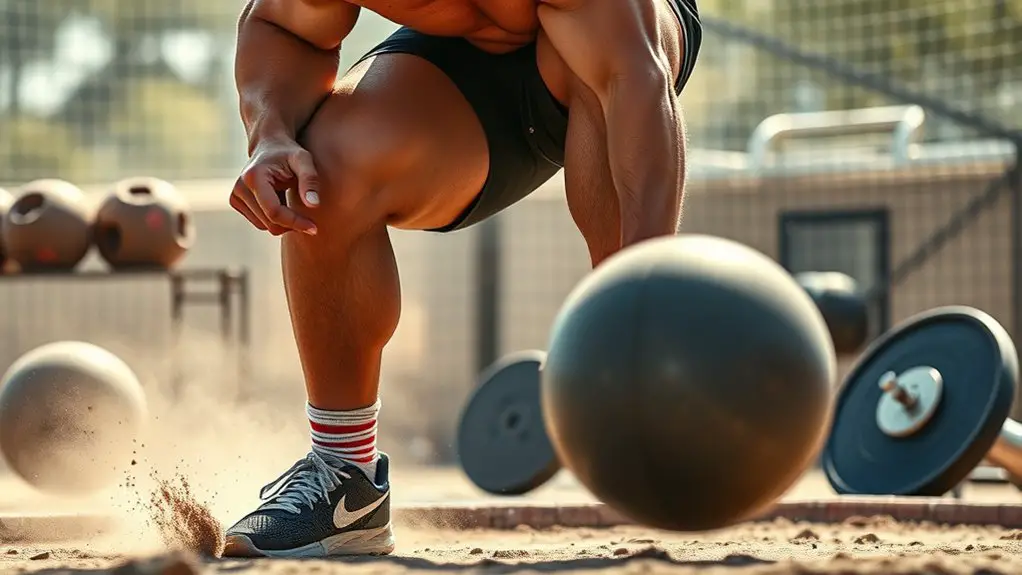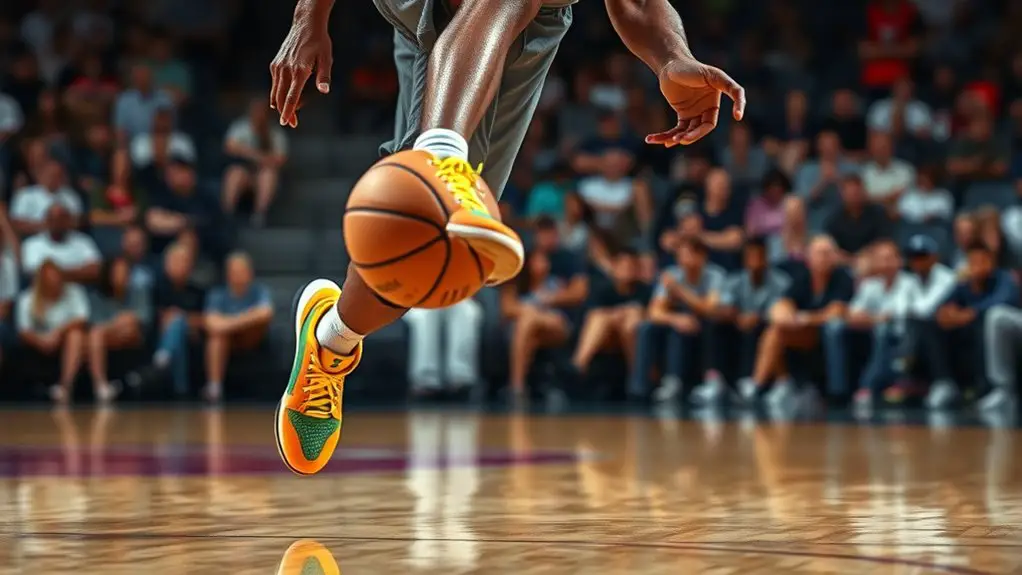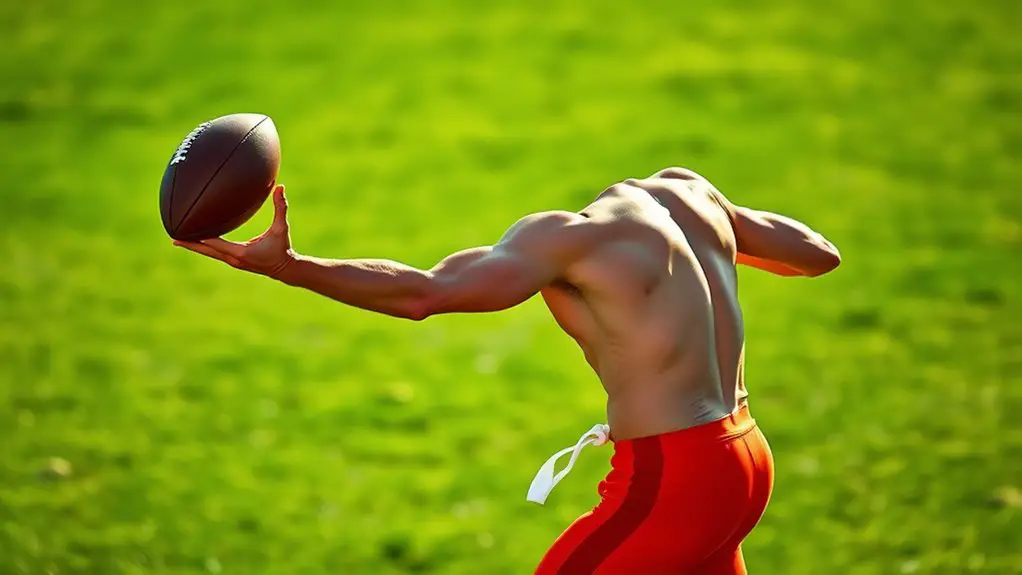To build power for throwing sports, focus on your throwing mechanics by engaging your hips and shoulders while maintaining a stable stance. Strengthen your core for better energy transfer, and incorporate plyometric exercises like medicine ball slams and box jumps for explosiveness. Don't forget about resistance training with compound lifts to enhance overall strength. Mobility and nutrition also play vital roles in performance. Stick around to uncover even more strategies for maximizing your throwing power.
Understanding the Mechanics of a Powerful Throw
When you want to improve your throwing power, it's essential to understand the mechanics behind a powerful throw. Start by focusing on your stance; your feet should be shoulder-width apart for stability. As you prepare to throw, engage your hips and shoulders, allowing them to rotate together. This kinetic chain is important; your legs generate power that travels through your core and into your arm.
Next, grip the ball correctly—firm but relaxed. As you release, snap your wrist to add velocity. Keep your follow-through fluid; this adds control and guarantees maximum distance. Remember, it's not just about raw strength but how you harness your body's natural movements. Additionally, incorporating core engagement during your practice can significantly enhance your throwing power.
Practice these mechanics regularly, and you'll find your throws becoming more powerful and precise. Embrace the freedom of movement and let your body express its strength through each throw!
Importance of Core Strength in Throwing
Core strength is a game-changer in throwing sports, as it acts as the foundation for generating power and stability. Without a strong core, you're missing the key element that connects your upper and lower body, which is essential for an effective throw. When your core is solid, you can transfer energy more efficiently, helping you release your full potential.
Think about how a powerful throw involves your entire body, not just your arm. A strong core stabilizes your movements, allowing for better balance and coordination. It helps you control your body's rotation and maintain a solid base, so you can focus on the throw itself. Additionally, a strong core enhances your ability to execute complex maneuvers, ensuring you can maximize your throwing performance.
Essential Plyometric Exercises for Explosive Power
How can you enhance your explosive power in throwing sports? Plyometric exercises are your secret weapon. These high-intensity moves train your muscles to generate maximum force in minimal time, boosting your power. Start with box jumps— they'll develop your leg strength and explosiveness. Next, try medicine ball slams; they mimic the throwing motion and engage your core while building upper body power. Depth jumps are also effective; they improve your reactive strength, helping you spring into action. Don't forget about plyometric push-ups, which will enhance your upper body explosiveness. Remember to focus on form and control to avoid injury. Incorporate these exercises into your routine, and you'll feel the difference in your throwing performance. Additionally, plyometric training can lead to increased power through fast-twitch muscle fibers, which is crucial for enhancing your overall athletic ability. Embrace the freedom of movement and push yourself to new heights!
Strength Training: Key Lifts for Throwing Athletes
When it comes to strength training for throwing athletes, focusing on key lifts can open up your potential. Olympic lifts, for example, enhance power and explosiveness, while core strength is essential for stability and control. Integrating plyometric exercises into your routine can further amplify your performance, creating a well-rounded training plan. Additionally, developing fast-twitch muscle fibers through strength training is crucial for maximizing your explosive power in throws.
Olympic Lifts Benefits
While many strength training methods can enhance your performance in throwing sports, Olympic lifts stand out for their unique benefits. These lifts, like the clean and jerk or snatch, focus on explosive power, which is essential for throwing. They engage multiple muscle groups, improving coordination and overall athleticism. By incorporating Olympic lifts into your routine, you'll develop strength that translates directly to your throws, helping you release your potential. Plus, the dynamic nature of these lifts promotes flexibility and balance, critical for any athlete. You'll also boost your mental toughness as you tackle challenging lifts, fostering a mindset that can benefit you in competition. Embracing Olympic lifts can truly elevate your game and set you free to perform at your best.
Core Strength Importance
Core strength is essential for athletes in throwing sports, as it serves as the foundation for powerful and controlled movements. When your core is strong, you're able to generate more force from your legs and transfer that energy through your torso to your arms, enhancing your throw. A stable core also helps maintain balance, preventing injuries and allowing for more freedom of movement. Incorporating exercises like planks, Russian twists, and medicine ball throws can greatly improve your core stability. These exercises not only build strength but also enhance your overall athletic performance. So, if you want to unleash your potential and throw with greater power, prioritizing core strength is a must. Embrace it, and watch your performance soar!
Plyometric Exercises Integration
Building a strong core lays the groundwork for integrating plyometric exercises into your training routine. These explosive movements, like box jumps and medicine ball throws, help you develop the power and speed needed for throwing sports. Start with basic exercises, ensuring your form is spot-on to prevent injury. Gradually increase intensity and complexity as you gain confidence.
Don't forget to focus on your landing mechanics; a soft landing helps absorb impact and maintain stability. Incorporate plyometrics 1-2 times a week, mixing them with strength training for a well-rounded approach. Listen to your body, and allow adequate recovery. Embrace this dynamic training style, and you'll release your potential on the field, feeling free and powerful during every throw.
Mobility and Flexibility: Enhancing Your Range of Motion
How can you enhance your range of motion to improve your throwing power? Focusing on mobility and flexibility is key. When you increase your range of motion, you allow your body to move more freely, which can lead to more powerful throws. Incorporate dynamic stretches into your routine to warm up your muscles and joints, preparing them for action.
Yoga and Pilates are excellent options for building flexibility, helping you to develop control over your movements. Don't forget about foam rolling; it releases tension in your muscles and improves blood flow, setting the stage for deeper stretches. Additionally, enhanced flexibility can significantly improve your coordination and balance, giving you a competitive edge in your throwing technique.
Drills to Improve Throwing Technique
Improving your throwing technique is just as important as enhancing flexibility and mobility. To really master your throws, start with the wrist flick drill. Stand with your feet shoulder-width apart and focus on snapping your wrist as you release the ball, ensuring you generate power from your core. Next, practice the step-and-throw drill; take a step forward with your non-dominant foot while throwing, which helps with balance and follow-through.
Another effective drill is the wall drill. Stand a few feet from a wall and throw the ball against it, focusing on your mechanics and ensuring your elbow stays above your shoulder. Finally, incorporate target practice. Set up targets at varying distances and angles, challenging yourself to hit them consistently. These drills will not only refine your technique but also empower your throws, giving you the freedom to perform at your best in any throwing sport. Additionally, incorporating plyometric exercises can further enhance your explosive throwing power.
Incorporating Resistance Training Into Your Routine
While you might focus on perfecting your throwing technique, incorporating resistance training into your routine is equally essential for building power. Resistance training enhances your strength, explosiveness, and overall athleticism, allowing you to realize your full potential. Start with compound movements like squats, deadlifts, and bench presses, which work multiple muscle groups and mimic the demands of throwing.
Aim for two to three sessions per week, focusing on heavier weights with lower reps for strength, or lighter weights with higher reps for endurance. Don't forget to include exercises that target your core, as a strong core translates to better stability and transfer of energy during throws. Additionally, Olympic lifts can significantly contribute to your explosive strength and overall power, which are crucial for throwing sports.
Listen to your body, and allow adequate recovery time. By blending resistance training with your throwing practice, you'll cultivate the power and freedom to excel in your sport. Embrace this balanced approach, and watch your performance soar!
The Role of Nutrition in Athletic Performance
Nutrition plays an essential role in your athletic performance, impacting everything from energy levels to recovery. By understanding macronutrients, hydration strategies, and meal timing, you can enhance your throwing power. Let's explore how these factors can support your training and competition efforts. Maintaining consistent meal timing is crucial for optimizing your energy levels and overall performance.
Macronutrients for Energy
When it comes to maximizing your performance in throwing sports, understanding macronutrients is vital. These nutrients—carbohydrates, proteins, and fats—fuel your energy needs and support muscle recovery.
| Macronutrient | Role in Energy | Sources |
|---|---|---|
| Carbohydrates | Primary fuel | Rice, pasta, fruits |
| Proteins | Muscle repair | Chicken, beans, nuts |
| Fats | Long-term energy | Avocados, oils, seeds |
Balancing these macronutrients helps you maintain energy levels and supports your training intensity. Carbs are important for quick bursts of power, while proteins assist in recovery. Don't forget about healthy fats, which provide sustained energy for longer workouts. By fueling wisely, you empower yourself to release your full potential in throwing sports.
Hydration Strategies for Performance
Effective hydration is essential for optimizing your performance in throwing sports, as even mild dehydration can greatly impair strength and coordination. To stay at your best, drink water consistently throughout the day, not just during workouts. Aim for at least half your body weight in ounces daily. When you're training, consider electrolyte-rich drinks, especially in hotter weather, to replenish lost minerals. Don't wait until you're thirsty; by then, you might already be dehydrated. Monitor your urine color—light yellow indicates good hydration. Before competitions, drink enough water, but avoid overhydrating to prevent discomfort. Remember, your body's performance hinges on your hydration habits, so make it a priority and enjoy the freedom of peak performance on the field!
Timing Your Meals
Hydration sets the stage for excellent performance, but what you eat and when you eat can make a significant difference too. Timing your meals around your training sessions fuels your body effectively. Aim to consume a balanced meal rich in carbs and protein about two to three hours before you throw. This'll give you the energy you need without feeling sluggish.
Post-workout, don't skip that recovery snack—ideally within 30 minutes. It's your chance to replenish glycogen stores and kickstart muscle repair. Listen to your body; if you're hungry, eat! Freedom in your nutrition choices is crucial, but structure in timing can elevate your performance. So, embrace the rhythm of your meals and watch your power soar!
Mental Strategies for Building Confidence and Focus
Building confidence and focus can greatly enhance your performance in throwing sports, especially when you understand the mental strategies that support these qualities. Visualization is key—imagine your successful throws in vivid detail. Affirmations can also be powerful; tell yourself you're capable and strong.
| Strategy | Description |
|---|---|
| Visualization | Picture your perfect throw |
| Positive Affirmations | Repeat empowering phrases |
| Mindfulness | Stay present, focus on your breath |
| Goal Setting | Define achievable, specific goals |
These strategies help create a mental space where doubt has no room. Practice them regularly, and you'll start feeling that freedom to express your full potential. Embrace the journey, and remember, confidence grows with each successful throw, making the sport feel exhilarating and liberating. Additionally, engaging in mental practice can reinforce the effectiveness of these strategies and further enhance your performance.
Frequently Asked Questions
How Does Throwing Technique Vary Among Different Sports?
Imagine the graceful arc of a discus flying through the air. Each sport's technique varies—baseball's overhand throw contrasts with javelin's linear motion, reflecting freedom in expression, yet all share the pursuit of precision and power.
What Role Does Mental Visualization Play in Throwing Performance?
Mental visualization's essential in enhancing your throwing performance. It helps you focus, imagine success, and build confidence. By picturing your ideal throw, you're more likely to replicate that motion during actual competition.
How Can I Prevent Throwing Injuries During Training?
You don't wanna be a gladiator in the arena of injuries! To prevent throwing injuries, focus on proper warm-ups, maintain good form, listen to your body, and incorporate rest days into your training routine.
Are There Specific Warm-Up Routines for Throwing Athletes?
You should incorporate dynamic stretches, mobility exercises, and sport-specific drills into your warm-up. Don't forget to include arm circles and torso twists to prepare your body for peak performance and reduce injury risk.
How Often Should I Practice My Throwing Skills?
You might think practicing every day's too much, but consistency is key. Aim for at least three to four times a week. This balance gives you freedom to improve without burning out or losing motivation.




